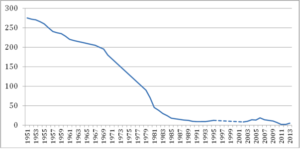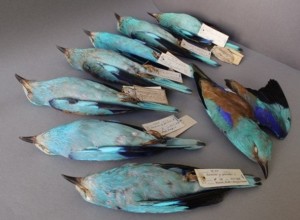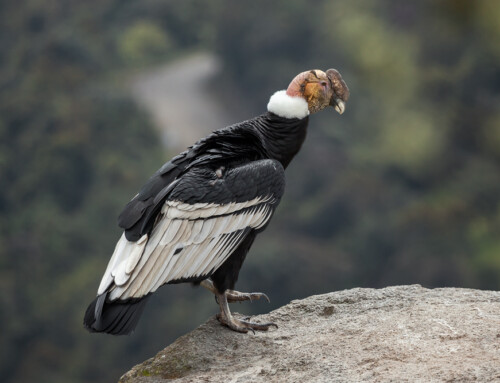LINKED PAPER
Witnessing extinction: Population genetics of the last European Rollers (Coracias garrulus) in Austria and a first phylogeographic analysis of the species across its distribution range. Nebel C., Kadletz K., Gamauf A., Haring E., Sackl P., Tiefenbach M., Winkler H. & Zachos F.E. 2018. Journal of Zoological Systematics and Evolutionary Research. DOI: 10.111/jzs.12256. VIEW
The European Roller (Coracias garrulus) is undoubtedly one of the most charismatic birds of the European avifauna. It is the only coraciid breeding in Europe and it spends the winter in sub-Saharan Africa (Fry et al 1992; del Hoyo & Collar, 2014). Globally, it is listed as a species of Least Concern by the IUCN; however, it has vanished from many European countries (Bohus 2002; Fry et al 1992; Glutz von Blotzheim & Bauer, 1980; Samwald & Stumberger 1997) and its numbers are dwindling in several more, especially in those located at the periphery of its distribution (Tokody et al 2017).
One of these countries is Austria that still harboured large numbers of European Rollers in the mid-20th century. Today, the species is restricted to a small area in South-East Styria. Since 2011, all European Rollers in Austria have carried color-coded rings, allowing to easily distinguish individuals (Tiefenbach 2015). The decrease in numbers is well documented and the population was relatively stable at 7 to 15 breeding pairs from the mid-80s to 2010 (Fig. 1). Then, following years with bad weather events during the crucial breeding period, the population saw a complete break-down (Sackl et al 2004; Samwald et al 2015). 2018 was the first year when no pair bred in Austria. Besides the reproductive isolation from neighbouring populations and a resulting high chance of inbreeding depression, the loss of suitable habitat is the main driver of the species’ extinction in Austria.

Figure 1 Graph showing the population decrease (in breeding pairs) between 1951 and 2013 in the European Roller population in South-East Styria (from Samwald et al 2015)
In our study, we had several aims:
- We wanted to quantify the loss of genetic diversity in the Austrian population through time. We collected blood from all Austrian Roller nestlings that hatched in 2005, 2007, 2014 and 2015 and compared these temporal cohorts. By using highly variable nuclear microsatellites and sequences of the mitochondrial control region, we compared the genetic diversity and structure of nestlings from 2005 to 2015.
- To find suitable donor populations to potentially restock the Austrian population, we included individuals from Hungary and Serbia (the two closest neighbours) and material from museum specimens collected in Austria at a time when the European Roller population was still considered healthy.
- By using the mitochondrial control region and by including many more individuals from across the distribution of the European Roller, we present a first phylogeographic analysis of the species.
 Figure 2 Even old specimens (before 1950) from museum collections often contain enough DNA for genetic analysis. For this study we successfully extracted DNA from European Roller feathers and food pad material and compared the historical individuals with contemporary populations © NHMW / Hans-Martin Berg
Figure 2 Even old specimens (before 1950) from museum collections often contain enough DNA for genetic analysis. For this study we successfully extracted DNA from European Roller feathers and food pad material and compared the historical individuals with contemporary populations © NHMW / Hans-Martin Berg
1. Genetic diversity in Austria
Given the low population number in Austria and no exchange with neighbouring populations, we expected a massive decrease of genetic diversity to complete monomorphism on all genetic levels. We found a decrease of mitochondrial diversity and today, the Austrian population can be considered as monomorphic (Fig. 3, “Cogar10”). However, genetic diversity based on nuclear DNA showed a different pattern: It decreased from 2005 to 2007, but instead of continuing this trend, genetic diversity increased between 2007 and 2015. We interpret this increase not because of immigration or mutation, but due to the nature of our sample sets: We used the entire offspring generation of a year and novel alleles found in 2014 and 2015 were probably already present in older gene pools but were not transmitted to offspring. Only in 2014 and 2015, they were carried by nestlings.
Effective population sizes are a good proxy to estimate how well a population can maintain its genetic diversity. We calculated it for the European Roller nestlings from 2005, 2007 and 2015 and saw it decrease from 24.8 (in 2005) to 2.2 (in 2015). In conservation genetics, an effective population size of 50 is considered as a lower threshold for natural populations before inbreeding depression is likely to occur (Franklin 1980).
2. Stochastic drift effects go mad in Austria
The STRUCTURE analysis revealed that the genetic structure has massively changed in Austria, very likely due to stochastic drift effects. The STRUCTURE pattern changed within only a few generations between 2007 and 2015. Interestingly, the historical Austrian samples and the samples from East Europe showed a similar genetic pattern, indicating that before the huge anthropogenic impact, Austrian Rollers were part of a continuous and genetically homogeneous population expanding to the east of the continent.
3. Phylogeographic split
The last part of the study focussed on the phylogeographic analysis of the European Roller in Europe and Asia. We found that in the network calculated with the mitochondrial CR sequences the European Roller is split into two haplogroups: one carried by individuals collected in Europe (the “European haplogroup”) and a second one that is carried by individuals in Asia (the “Asian haplogroup”). The distribution of the two genetic lineages is (almost) in accordance with the distribution of the two subspecies, the nominate form C. g. garrulus in Europe and subspecies Coracias garrulus semenowi in Asia.

Figure 3 Network of control region sequences of Coracias garrulus. It contains a total of 41 haplotypes. Each dash between haplotypes denotes a single mutational step. Sizes of haplotype circles do not reflect frequencies. Numbers beside haplotypes correspond to the respective haplotypes Cogar1-Cogar41. Origin: AUT: Austria, AZ: Azerbaijan, Balkans: Serbia, Montenegro and Bulgaria, CZ: Czech Republic, ES: Spain, HU: Hungary, IN: Iran, IR: Iraq, TR: Turkey, UZ: Uzbekistan
Although the European Roller is at the brink of extinction in Austria, our study shows that even with small population numbers, it was able to remain relatively high levels of heterozygosity. Genetic structure changed dramatically due to genetic drift effects within a few generations. Generally, the species harbours relatively high levels of nuclear diversity, while on mitochondrial level we found almost every individual (outside of Austria) to carry unique haplotypes.
Nominate this article for a BOU Science Communication Award.
References
Bohus, M. 2002. On breeding biology of the roller (Coracias garrulus) in the Komarno town surroundings (SW Slowakia, Danubian basin). Sylvia 38: 51–59. VIEW
Del Hoyo, J., & Collar, N.J. 2014. HBW and Birdlife International Illustrated Checklist of the Birds of the World. Volume 1: Non-passerines. Barcelona, Spain: Lynx Edicions.
Franklin, I.R. 1980. Evolutionary change in small populations. In M.E. Soulé, & B.A. Wilcox (Eds.), Conservation Biology: An Evolutionary-Ecological Perspective (pp. 135–149). Sunderland, MA: Sinauer.
Fry, C.H., Fry, K., & Harris, A. 1992. Kingfishers, Bee-eaters and Rollers. London, UK: Christoph Helm.
Glutz von Blotzheim, U.N., & Bauer, K.M. 1980. Handbuch der Vögel Mitteleuropas, Vol. 8. Wiesbaden: Akademische Verlagsgesellschaft.
Samwald, O., & Stumberger, B. 1997. Roller Coracias garrulus. In W.J.M. Hagemeijer & M.J. Blair (Eds.) The EBCC Atlas of European Breeding Birds: Their Distribution and Abundance (pp. 436–437). London: T & AD Poyser.
Sackl, P., Tiefenbach, M., Ilzer, W., Pfeiler, J., & Wieser, B. 2004. Monitoring the Austrian relict population of European Roller Coracias garrulus – a review of preliminary data and conservation implications. Acrocephalus 25: 51–57. VIEW
Samwald, O., Tiefenbach, M., Albegger, E., & Samwald, F. 2015. Blauracke Coracias garrulus (Linnaeus, 1758). In E. Albegger, O. Samwald, H. W. Pfeifhofer, S. Zinko, J. Ringert, P. Kolleritsch, … W. Stani (Eds.), Avifauna Steiermark – Die Vögel der Steiermark (pp 509–513). Graz, SA, Austria: Leykam Buchverlag GesmbH Nfg & Co KG.
Tiefenbach, M. 2015. Endbericht über Monitoring und Management Maßnahmen zur Verbesserung der Überlebenssituation der Blauracke in der Steiermark im Jahr 2015. Graz, SA, Austria: Amt der Steiermärkischen Landesregierung.
Tokody, B., Butler, S.J., Finch, T., Folch, A., Schneider, T.C., Schwartz, T., … Kiss, O. 2017. The flyway action plan for the European Roller (Coracias garrulus) (p. 37). UNEP/CMS/COP12/Doc.24.9./Annex 1.24 May 2017. VIEW
Image credits
Featured image: European Rollers Coracias garrulus © Michael Tiefenbach





